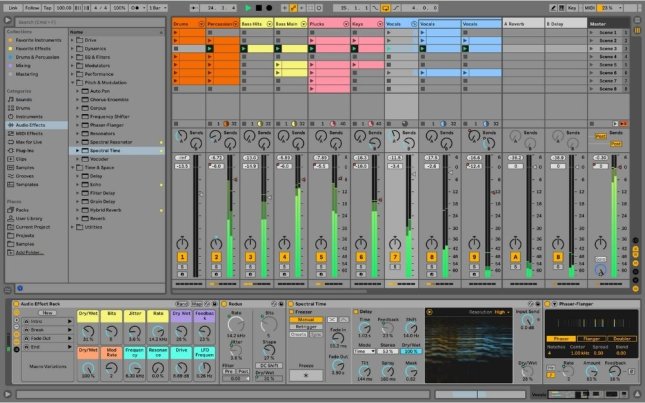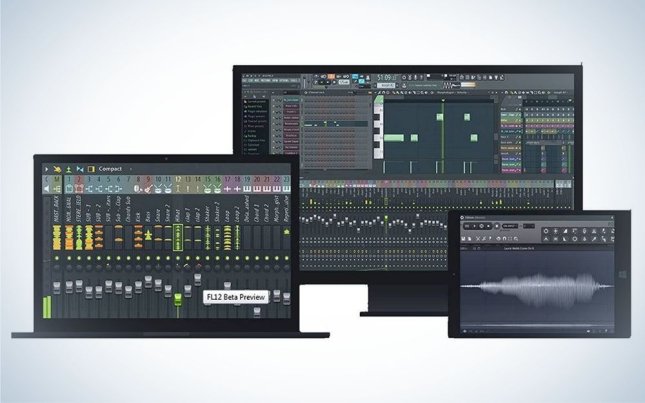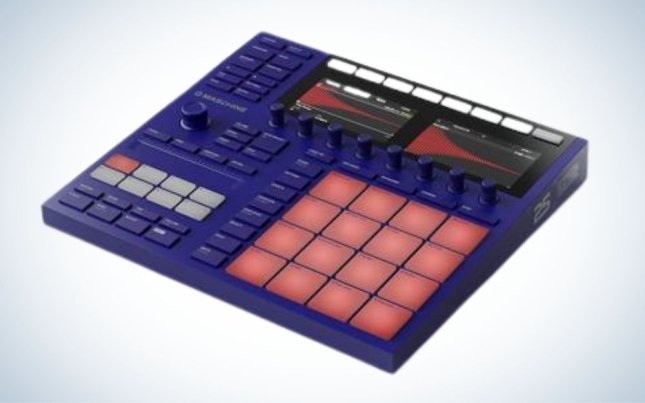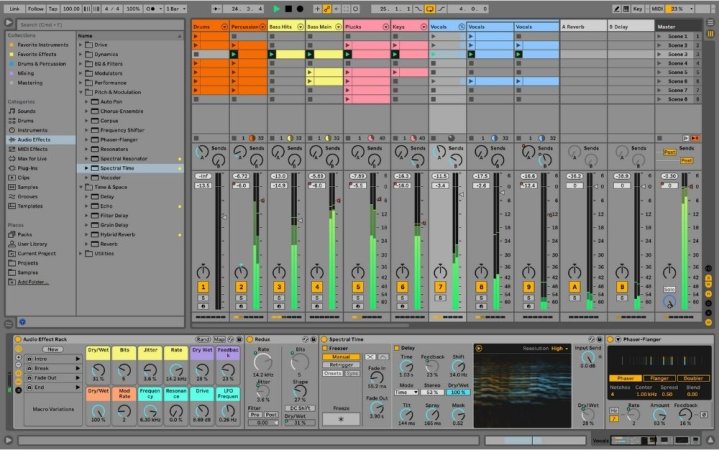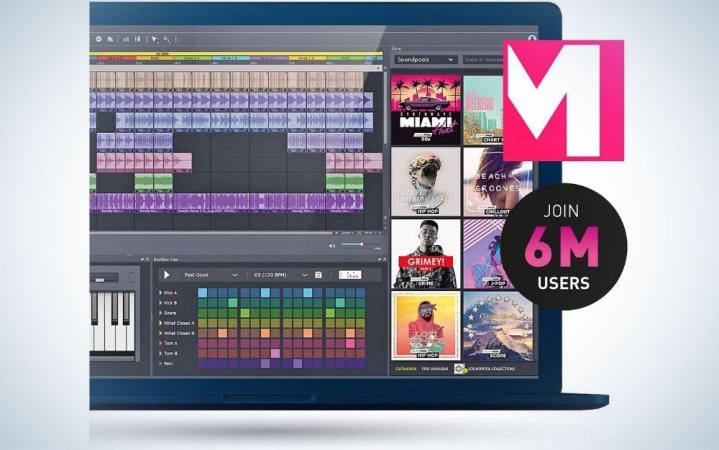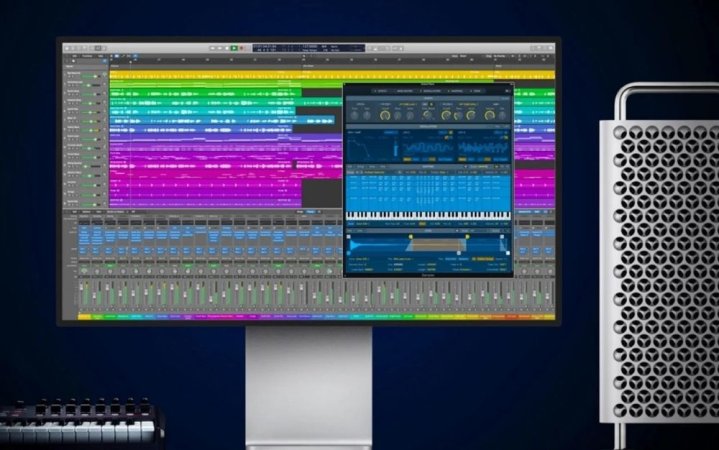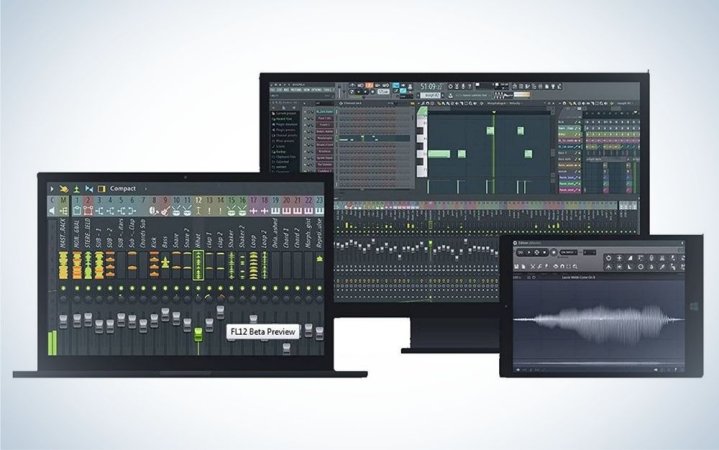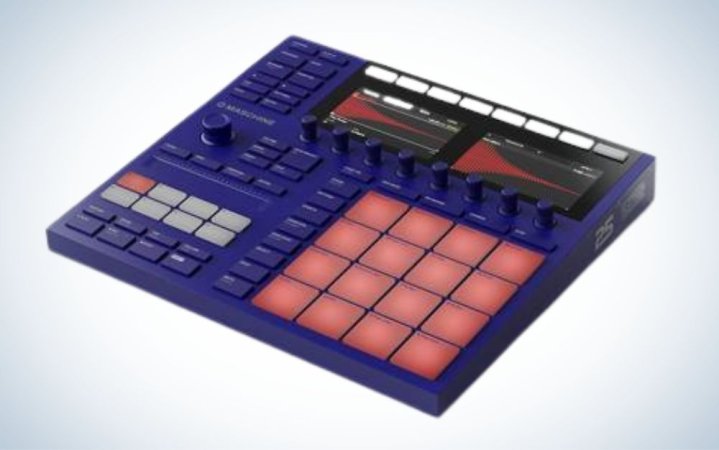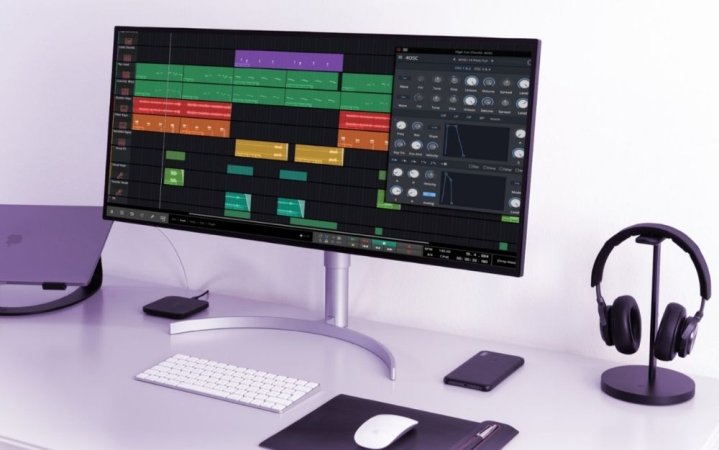We may earn revenue from the products available on this page and participate in affiliate programs. Learn more ›
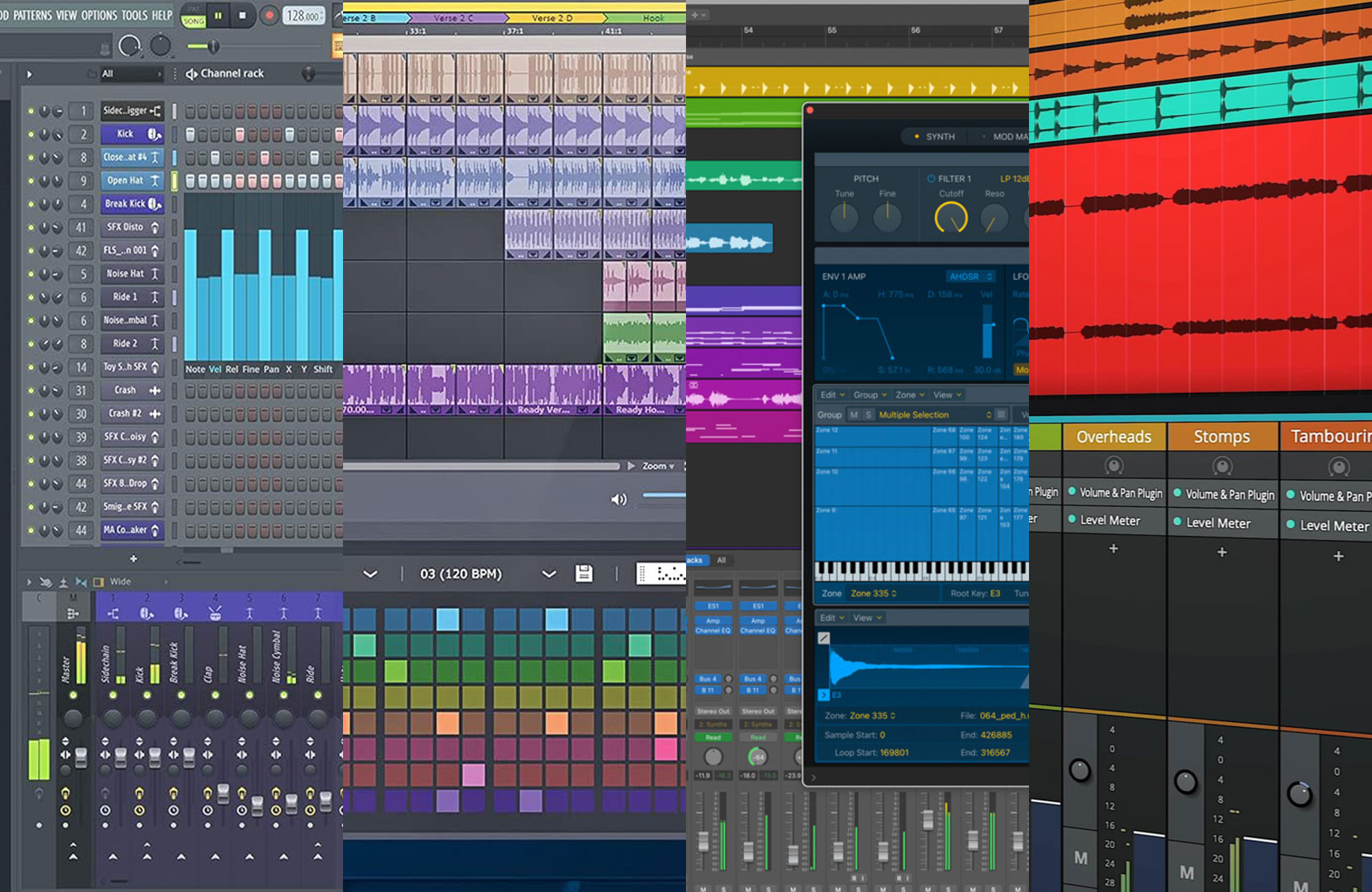
Whether you make beats as a hobby, grind away full-time to shop your tracks, or are just getting started as a complete beat-making beginner, your choice of software matters. Some of the best beat-making software programs are also among the best digital audio workstations for all music production, but others are more focused specifically on beat-making or making sure that they are beginner-friendly. The most important thing is that you have the passion and work ethic to make the most banging beats you can, but when you’re head-down and lost in the flow of drums and basslines, you want to make sure your software is helping you and not getting in the way. That’s why, while these software programs are diverse in what they offer, they all make great centerpieces for a beat-making studio to really make speakers push air. The best beat-making software for you will take into account your comfort level with music software, your goals for how big you want to go, and the computer, other software, and other music hardware you use or plan to use.
- Best overall: Ableton Live 11
- Best for beginners: Magix Music Maker 2022 Premium
- Best for Mac: Apple Logic Pro
- Best for Windows: Image Line FL Studio 20 Producer Edition
- Best for hip-hop beats: Native Instruments Maschine
- Best for free beats: Tracktion Waveform Free
How we chose the best beat-making software
I have first-hand experience with most of this software from almost 20 years of working with the best DAWs and the best music production software. That experience comes from making music as well as reviewing and editing full-time with outlets such as Electronic Musician, MusicTech, Mix, and DJTechTools. Yet because my own opinions and experience are still not enough to have tried every track-crushing option in the vast array of high-quality beat-making software, I have also scoured the habits and preferences of professional music producers and taken the input of other trusted expert editors, reviewers, and pundits.
The best beat-making software: Reviews & Recommendations
These recommendations for the best beat-making software run the gamut of price and included features. Some are more outwardly aimed at beginners, while others are suitable to pros, but all of them offer something to beat-makers of every level. What brings them all together in a single group is their appeal to the specific needs of pattern and loop-based beat production, which covers many genres such as hip-hop, lo-fi, dance music, trap, and others. To differing degrees, these programs can also be used for recording bands, sound design, composing, etc., but paired with some great studio monitors or mixing headphones they are all excellent choices for beat-making.
Best overall: Ableton Live 11
Best beat-making software
Pros
- Versatile workflow combines loop-based beats with linear track recording
- Excellent manipulation of “elastic” audio and audio extraction features
- Made for live performance in addition to beat-making
- Large amount of included instruments, audio content, and audio & MIDI effects
Cons
- Comparatively high price
- Step sequencing not great without the Ableton Push hardware controller
Why it made the cut: Ableton Live has become the most popular beat-making software for independent electronic musicians, hip-hop beat-makers, and bands, not because of groupthink but because of a maturely developed, diverse, infinitely creative tools aimed at music production and live performance.
Specs
- Multitrack recording up to 32-bit/192kHz audio
- Instrument Racks for saving instrument/effect combinations
- Real-time audio stretching with several “warp” modes
- Full MIDI features, including controlling hardware synths
- Video support
Ableton Live gained notoriety for loop-based music composition and treating audio material elastically, so you can bend, stretch, and slice audio in real time to make it behave how you want. For years now, Live has combined its music loop approach with full-scale DAW capability for creating music on a linear timeline, so it’s now as much of a viable option to movie composers as beat-makers.
Live thrives on creative flexibility, from its customizable GUI to its many instruments and effects devices, which can be combined, automated, and assigned to macro controls for infinite possibilities. Each update adds more audio and device content and abilities, such as Live 11’s comping for compiling multiple recording takes into a single track, and the option to link multiple tracks and edit them as one.
With Ableton Link wireless network tempo syncing, you can jam in time with other Live users as well as a large number of iOS apps and desktop music software programs. The Ableton Push 2 hardware controller pairs seamlessly with Live software to make step sequencing beats, automating effects, and many other tasks faster.
Best for beginners: Magix Music Maker 2022 Premium
Best beat-making software for beginners
Pros
- Affordable
- Approachable to beginners
- Song Maker AI creates tracks with a few clicks
- Beatbox Pro easy step-sequencing drum machine
Cons
- Windows-only
- Many of the instruments, effects, and Soundpools are in-app purchases
- No upgrade path to a high-end pro DAW program
Why it made the cut: Music Maker 2022 Premium has continued to expand its appeal to beginning beat-makers with a new modular interface and artificial intelligence that make beat production even easier than before.
Specs
- Unlimited tracks
- 64-bit and multicore support
- VST plug-in support
- Burns CDs and DVDs
- 6 effects included
Combining an entry-level price with an approachable workflow, Magix Music Maker 2022 unabashedly targets beginner beat makers. Its straightforward, modular, one-window interface includes a content browser where users drag and drop virtual instruments, effects, and content packages called Soundpools into the project. The Soundpools are genre-based collections of loops, sounds, patterns, and instruments that are intended to jump-start song ideas. You can create as easily as mixing and matching loops, or take it further by writing your own parts and polishing the production in the MIDI note editor and mixer.
Going one step further in assisting beginners, the 2022 version of Music Maker adds the Song Maker AI, an artificial intelligence assistant that creates new beat compositions based on your choice of different Soundpools, instruments, and song parts (verse, chorus, break, etc.). Song Maker AI comes up with a new result every time, and you can fully modify it with your own ideas. The new Beatbox Pro 8-part drum machine also simplifies beat-making with its color-coded step sequencing.
The program comes with a selection of virtual instruments, audio effects, Soundpools, and audio content, with many more devices, Soundpools, and hundreds of thousands of loops and samples across most genres available for in-app purchasing. Music Maker lets you input notes from a mouse or computer keyboard but also includes full hardware integration with the budget-priced Novation Launchpad Mini MK3 pad controller and the Alesis Q49 MKII and Akai MPK Mini MK3 keyboards. Magix claims more than 6 million Music Maker users, and they can all share their creations and collaborate in the Magix Producer Base Community.
Best for Mac: Apple Logic Pro
Best beat-making software for Mac
Pros
- Live Loops grid for non-linear beat-making
- Easy but powerful Step Sequencer
- Drum Machine Designer and “acoustic” Drummer with tons of drum kits
- Free iOS multi-touch app controller
Cons
- Mac-only
- No support for VST plug-ins
Why it made the cut: Logic Pro has been a tremendous value and a top choice for professionals for years and now a wonderful complement of new tools makes it equally attractive to beat-makers.
Specs
- 25 software instrument plug-ins
- 79 effect and MIDI plug-ins
- 13,552 included Apple loops
- 1,360 Sampler/Quick Sampler instruments
- 5,953 total presets for instruments and devices
Apple Logic Pro has always been a go-to DAW for high-level producers and composers (it integrated Dolby Atmos mixing, for example). But with the Logic Pro 10.5 update, Apple’s software also earned the attention of beat-makers with a slew of new features that put it in competition with Ableton Live. Among those additions, the Live Loops grid makes non-linear jamming and beat-making spontaneous and fun. The excellent new Drum Machine Designer and Drum Synth make creating custom drum kits relatively easy, and the simple yet deeply featured Step Sequencer puts hyped beats just a few clicks away.
A free iOS control app turns an iPad or iPhone into an amazing multitouch Logic Pro controller, perfect for quickly making step-sequenced drum beats, operating the mixer, and tweaking the new Remix FX DJ-style effect touchpads.
At just under $200, Apple Logic Pro presents one of the greatest values in all of music software, whether you’re making beats or scoring films. And beginners starting off with GarageBand for iOS or Mac can import all their projects into Logic Pro’s fully professional software suite.
Best for Windows: Image Line FL Studio 20 Producer Edition
Best beat-making software for Windows
Pros
- Unique pattern creation and sequencing workflow
- Project templates for getting started
- Supports multi-touch displays
- Includes lifetime free updates
Cons
- Audio recording and editing not as robust as other DAWs
- Quick to get started but more complicated to go deeper
Why it made the cut: FL Studio 20 Producer Edition gives beginners and veterans alike a powerful loop- and pattern-based beat machine for making tracks fast.
Specs
- 89 Instruments and Effects
- Audio recording, editing, and audio clips
- Full MIDI support
- 3rd-party VST plug-in support
As FL Studio developed from almost a music-based game into one of the best-loved tools for pattern- and loop-based genres like electronic dance music and hip-hop, it kept its unique pattern-based workflow that lets you make beats very quickly. Its ease and speed have won over many successful producers, including notable names such as Martin Garrix, 9th Wonder, Tritonal, and Mike WiLL Made-It.
Its multitrack Channel Rack helps you step-sequence drum beats fast, which go into a Pattern Picker for arranging into the Playlist, which becomes the full song. The resizable and rearrangeable interface also features Paint and Stamp tools and a famously robust Piano Roll for programming or recording chords and MIDI note melodies. FL Studio 20 Producer Edition has full audio recording capability, as well as powerful synthesizers, virtual instruments, and effects and dynamics plug-ins for mixing and mastering. Stylistically themed templates can get you started, and when you’re finished with a track, the Visualizer lets you render 4K videos to go with your music.
While FL Studio works on Mac and Windows machines, it came to maturity as a Windows program, and its multitouch display support gives a special advantage to Windows touchscreen computer users. Many FL Studio producers have been known to make hits on just a laptop with no additional hardware, but the compact, inexpensive Akai Professional Fire controller seamlessly controls the major aspects of FL Studio, including sequencing, note input, mixing, and interface navigation.
Best for hip-hops beats: Native Instruments Maschine
Best hip-hop beat-making software
Pros
- Tightest integration imaginable between software and hardware
- Bridges old-school drum sampler workflow with modern technology
- Focused, fast methodology
- Software works inside other DAWs as a plug-in
Cons
- Not available as software only
- Doesn’t perform full multi-track audio recording
Why it made the cut: Native Instruments Maschine brings the classic sample-chopping beat-making of MPC workstations into a modern software/hardware system that has resonated with a legion of hip-hop producers, as well as dance-music maestros.
Specs
- Imports MPC programs and WAV, AIFF, REX2, and MIDI files
- 25 creative and mixing effects
- 58 GB library of loop and one-shot samples, sampled instruments, synthesizers, and drum kits
- Native Instruments NKS compatible
- 3rd-party VST/AU plug-in support
Unlike the other programs in this list, the Maschine software only comes as a companion to Native Instruments’ beat-making pad controllers, Maschine Mikro MK3, Maschine MK3 (which includes an audio/MIDI interface for connecting a microphone, instruments, and speakers to the system), and the Maschine+ (which also works as a standalone unit without a computer connected). As an advantage, the controllers work in absolute lock-step with the software so that you have tight, efficient control over the software’s professional mixer and all of its virtual instruments and effects. Many different pad modes let you play full chords, single notes, or step-sequence drum patterns from the pads. The eight hardware knobs control every function of instrument and effect devices, and hardware shortcut buttons open software windows for the sampler, track arranger, mixer, and the excellent tag-based content browser.
Maschine adapts many of the best aspects of the MPC sampling sequencers from the 1990s that heavily influenced much of hip-hop music production, then folds them into a clean, focused visual interface that leans on a clip-based pattern sequencing to construct musical scenes that you build into full-length tracks. It excels at chopping and pitch-shifting sampled audio and loops, MIDI editing, and parameter automation. This has endeared Maschine to many champions of the old MPC units, such as DJ Shadow and DJ Jazzy Jeff, as well as to many other modern hip-hop and electronic producers, such as Kaytranada, Mike Shinoda, El-P, Odesza, Diplo, RJD2, and London On Da Track.
Maschine does not have multitrack audio recording, but you can record internal and external audio as samples. To incorporate Maschine into music-making without limits, you can open the software in any DAW program as an AAX/AU/VST plug-in.
Best for free beats: Tracktion Waveform Free
Best free beat-making software
Pros
- Multitrack audio and MIDI recording and editing
- Step-sequencer clips for fast beat-making
- Focused on ease of use with project templates, Pattern Generator, tutorials, etc.
- Shortcuts from the Actions Panel
Cons
- Missing many devices and production features of the paid version
Why it made the cut: Besides it being a well-executed program by any standard for making beats efficiently, Waveform Free is also the closest thing to gaining the uninhibited DAW experience for free.
Specs
- Unlimited track count
- Supports 3rd-party plug-ins
- Available for Linux, Raspberry Pi, Mac, and Windows
Tracktion Waveform Free is the entry-level version of the Waveform Pro DAW software. While it’s been stripped of many of the high-level mixing and editing tools, virtual instruments, and effects devices from the paid version, Waveform Free distinguishes itself from many other free DAW versions in that it has no timeouts, no watermarks, no track-count limit, no export/render restrictions, no 3rd-party plug-in restrictions, no saving or project limitations, and no copyright restrictions (meaning you can legally share/sell the music you create with it). It includes a full-featured mixer and a basic set of processing plug-ins, a synthesizer, and the Micro Drum Sampler. In addition, dozens of included presets for the Plug-in Racks allow for complex processing and sound design.
Despite being a scaled-down version, Waveform Free still includes some of Tracktion’s intriguing technology that has made it an award-winning program. The time-saving and beginner-friendly Pattern Generator puts preset—but editable—chord progressions, basslines, arpeggios, and melodies a click away. Unique step-sequencer clips put a handy spin on drum beats by embedding the step-sequencer within a track on the timeline. These sequences sync with the Micro Drum Sampler and have their own larger, dedicated editor view. Another time-saving convenience, the Actions Panel, lets you “favorite” your most-used actions and create custom actions as time-saving shortcuts.
While there is no obligation to upgrade Waveform Free, there are plenty of opportunities to add on (for a fee) samplers, synthesizers, audio content packs, and other options or to upgrade to a version of Waveform Pro at any time.
What to consider when buying the best beat-making software
Your experience level may be a factor in which beat-making software you buy. If you’re completely new and possibly intimidated by how complicated music software can appear, there are beginner-oriented options for you here. Every program will have some learning curve and it’s okay to have to take some time to learn the workflow; your efforts will pay off in the end. If you’re confident that you’re going to stick with beat-making, you can start fresh with any of the programs listed here. There are other things to consider, though, such as the type of computer you have, your budget, and whether you will use the beat-making software with other plug-ins, hardware devices, and bandmates.
Operating system
Your computer’s operating system is not exactly a life sentence; there are emulator programs to make Mac software run on Windows and vice versa. However, adding that layer of complexity just takes away from actually making your best beats, and there are plenty of choices for the biggest operating systems.
The only Windows-only software on this list, Magix Music Maker 2022 Premium, presents an affordable yet powerful option aimed at beginning beat-makers. It has its own character and workflow, but it works as a Windows counterpoint to the GarageBand music-making software that comes installed in all new Apple computers. GarageBand users wanting to step up to one of the best buys for beat-making can upgrade to the Mac-only Logic Pro for less than $200.
The rest of the options here are cross-platform, but if you have a Windows touchscreen machine, you may want to pay special attention to Image Line FL Studio 20, which supports touchscreen computers. For beat-makers using Linux or even Raspberry Pi operating systems, Tracktion Waveform Free has you covered with an excellent entry-level DAW that you can upgrade to the high-end professional version if you wish.
Price
The almighty dollar always stays on the mind of beat-makers, at least until you work your way up to being a high-priced producer for hire or platinum hit-maker. Fortunately, you don’t always have to spend big bucks to make fat beats. Among the best cheap beat-making software, Tracktion Waveform Free lets you dive into beat-making without financial risk, and upgrading to Waveform Pro only costs $119. Magic Music Maker 2022 Premium can be had for less than $100, and both FL Studio 20 Producer Edition and Logic Pro give you a lot of value for less than $200. Native Instruments Maschine costs more, because it only comes with hardware, starting at $269 for the Maschine Mikro. One of the most popular and powerful beat-making programs overall, Ableton Live 11, costs a bit more than average for DAW software at $449 for the standard version, and $749 for Live 11 Suite. Both Live 11 editions supply you with a huge amount of audio material, instruments, and effect devices to keep you busy beat-making for a long time to come.
What else will you use to make beats?
If you plan on making beats with a laptop only, the software discussed here will let you be productive using only the computer keyboard and mouse to enter drum and melodic notes, record, edit, and mix your music.
However, if you plan to expand your beat-making studio with other equipment—like vocal microphones and especially keyboard and/or drum pad controllers—take a look at which hardware controllers these music programs support. Generally, you can use any MIDI-compatible keyboard and drum pad controllers, but to go beyond the basic operation of playing notes, you may have to MIDI-map the hardware to specific software functions. That can be a complicated process that most beat-makers would rather not do. Instead, you can opt for the specific hardware that fully integrates with the software out-of-the-box (for instance, NI’s Maschine or Ableton’s Push), so that mixing, sequencing, controlling virtual instruments, and other tasks work much better without any extra programming. There are some hardware suggestions in the product overviews below. See the software developers’ websites for additional hardware compatibility.
Also, consider if you’re planning to make beats as part of a larger band that will record multitrack audio. Native Instruments Maschine doesn’t perform multitrack audio, but you can open it as a plug-in inside other recording software. The rest of the programs here record multitrack audio, so consider your audio recording needs against the other strengths of the software (and plan on investing in a USB interface accordingly).
FAQs
Yes, you can make beats with just a laptop, but most producers eventually graduate to expanding their setup to more than just a laptop with software. However, if a laptop and software are all you have, go for it. All of the programs outlined above have the ability to enter melodic notes and percussive beats either just with a mouse or with a keyboard or drum machine interface that uses your keyboard’s keys. A laptop’s internal microphone is usually not the ideal way to record vocals, instruments, or other sounds for a musical production, but it can suffice if it’s all you have. The basic hardware for beat-making—including a microphone and audio interface for improving the quality of recorded sound, a keyboard and/or pad MIDI interface for making track recording easier and more natural, and headphones and/or speakers for better listening—can be bought for a few hundred dollars at the low end. However, they can also tempt you to spend beyond your means, so don’t let financial constraints get in the way of your musical ambitions. If you need to make beats with just a laptop, you can do it.
The easiest beat-maker probably is a mobile app that lets you combine a few loops into a semi-original beat, but falls short of being a real artistic tool. When it comes to making original beats you can really call your own on desktop programs like those profiled here, Magix Music Maker 2022 Premium is the most oriented to being easy for beginners. Its Song Maker AI component uses AI to combine sets of genre-specific loops into new combinations that you customize. That arguably makes the beat-making process a little too easy, but the software also lets you build beats from scratch in an intuitive way. Since Music Maker is for Windows only, Mac users can relax knowing that the easiest beat-making software for them comes free on every Apple computer: GarageBand. It makes playing musical parts and putting together tracks easy and fun, and it can import songs from the GarageBand iOS app or export songs to Apple’s high-end DAW, Logic Pro.
It can be a little confusing figuring out how expensive FL Studio is, because it comes in four different editions, from the entry-level to the most deluxe edition. FL Studio Fruity Edition ($99) does not allow audio recording and comes with the smallest selection of audio and effect native plug-ins. FL Studio Producer Edition ($199) adds audio recording and six additional plug-ins. The FL Studio Signature Bundle ($299) adds another 13 plug-ins on top of the previous editions. Finally, the FL Studio All Plugins Edition ($499) includes all the available features and plug-ins. Also, you can get a version of FL Studio software when you buy certain hardware controllers, such as the very handy and portable Akai Fire. Fortunately, all the different FL Studio editions come with lifetime updates, and can always be upgraded from lower to higher tiers.
Final thoughts on the best beat-making software
- Best overall: Ableton Live 11
- Best for beginners: Magix Music Maker 2022 Premium
- Best for Mac: Apple Logic Pro
- Best for Windows: Image Line FL Studio 20 Producer Edition
- Best for hip-hop beats: Native Instruments Maschine
- Best for free beats: Tracktion Waveform Free
While beat-making is often a solitary experience, most producers eventually collaborate with others. So while Ableton Live 11 could be the best overall beat-making software on its own merits, it also has one of the largest user bases of all music software. That not only means that you can more easily collaborate with a larger number of producers by sharing Ableton sessions, but it also has resulted in a huge Ableton Live community for tutorials and 3rd-party content that’s specific to the software. But your choice should still be a personal decision based on your style of working, your studio setup, your budget, and whatever intangible vibe you get from each program. What’s a beat anyway if the vibe’s not right?
